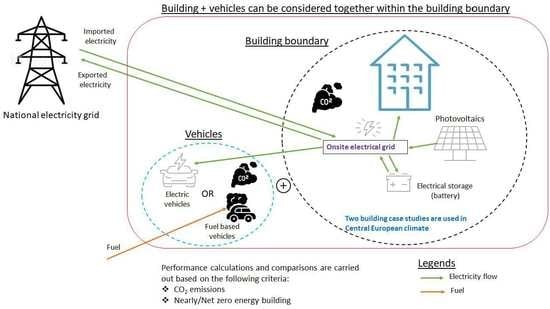Energy and Emission Implications of Electric Vehicles Integration with Nearly and Net Zero Energy Buildings
Abstract
:1. Introduction
- There is a shift of mobility energy in terms of the building’s energy meters. A gap exists in the methods of integrating the buildings and EVs due to the addition of EVs’ charging energy from the building’s energy meters [31]. Synchronisation is needed to support the energy efficiency of building and e-mobility integration. With the integration of EVs in a building, the primary energy use increases, resulting in lower performance levels of the building. However, new methods are needed to show the advantage of integrating EVs with buildings and replacing fossil fuel-based cars, especially in terms of emissions. These novel methods are proposed in the paper.
- The current EU’s NZEB criteria laid down under the EPBD directive does not explicitly include the mobility within the building boundary and in the NZEB calculations. Therefore, a novel approach and method is discussed in the article to present the benefits of including mobility within the building boundary and NZEB/Net ZEB calculations. It is proposed to follow the emission calculation path rather than energy calculation path to show the benefits. This is further discussed by presenting two real measured case studies.
- The studies discussed earlier are generally based on simulations; however, studies that involve real measurements are required to argue about the concept and impact on NZEB and Net ZEB criteria with the inclusion of EVs. Therefore, two real case studies are discussed in the paper to support the novel approach of including mobility and follow the emission path, rather than energy calculation path. It also demonstrates the benefits, in real case scenarios, of including mobility within the building’s energy balancing boundary.
2. NZEB Critical Analysis from the EV Penetration Point of View
2.1. NZEB and Net ZEB Definitions
2.1.1. Critical Analysis on the NZEB Criterion (Primary Energy) and Member State Plans
2.1.2. EU Member States and Other Countries Plans for EV Integration
- Norway
- The Netherlands
- France
- Germany
- Sweden
2.2. Proposed Approaches to the Policy Plans
2.2.1. Exclude EVs in the Demand Calculation of NZEB
2.2.2. Include EV Load in the Assessment Procedure
- Increasing the permissible primary energy criterion for NZEB
- EV and fossil fuel-based cars’ CO2 emissions comparison
2.2.3. Additional Services in Terms of Building Energy Performance and Flexibility
- Load shifting
- Vehicle to Grid (V2G)
- Vehicle to Building (V2B)
2.2.4. Challenges and Opportunities in Future Integration of EVs
- Smart grids
- Demand-side management
- Business models
- Urban development plans and regulations
- Energy performance certificates of the buildings
3. Methods
3.1. Case Studies
3.1.1. Input Data
3.1.2. NZEB Definitions and Calculations Methods
4. Results
4.1. Case Study 1: Terraced Single-Family Dwelling
4.1.1. Input Data Specifications
4.1.2. Flemish NZEB Criteria
4.1.3. Sensitivity Analysis 1: PV Sizing
- EVs are not included in the NZEB calculation or there is no EV on site (black line);
- EV mileage is 10,000 km per year (blue line)
- EV mileage is 20,000 km (red line)
4.1.4. Sensitivity Analysis 2: EV Mileage
4.1.5. Sensitivity Analysis 3: Heat Load
4.1.6. Net ZEB Estimation
4.1.7. CO2 Emissions
4.2. Case Study 2: Belgian Single Family House
4.2.1. Input Data Specifications
4.2.2. Base Case Results
4.2.3. NZEB Criteria and EV Inclusion
4.2.4. Sensitivity Analysis 1: PV Sizing
4.2.5. Sensitivity Analysis 2: EV Mileage
4.2.6. Sensitivity Analysis 3: Heat Load
4.2.7. Net ZEB Estimation
4.2.8. CO2 Emissions
5. Discussion: Way Forward
6. Conclusions
- Exclude EVs from the building boundary.
- Include EVs in the building boundary,
- ○
- Increase the permissible criterion of primary energy under NZEB.
- ○
- Estimate and calculate the building’s performance based on the CO2 emissions.
- In both the two case studies presented in this paper, the Net ZEB calculations and NZEB calculation showed discrepancies when calculated to meet the respective criteria. It is highly dependent on the PV capacity, plug loads and EV load.
- More dynamic NZEB evaluation methods based on instantaneous coverage of the load will cause violations of the requirement in many cases, especially when EVs are included.
- Larger capacities of RE generations are needed in the NZEB buildings to remain within the allowable limits of NZEB or Net ZEB when an EV is integrated.
- A well-insulated single-family dwelling equipped with PV, PV/T and tanks to cover the yearly electricity demand of a house should be able to meet the Flemish NZEB requirement, which also includes the charging demand of EVs.
- When an EV is included with the building, the primary energy usage increases; however, the overall emissions decrease when compared with fossil-fuel driven cars.
- One method to maintain the NZEB level of the calculated building is to alter the NZEB permissible limits within the regulations to allow building’s with EVs to remain within the NZEB regulations.
- Another method is to follow the emissions path, rather than the energy path, which can show the benefits of the inclusion of the EV with the building. The emission estimation path provided a better picture of the benefits of including EVs within the building’s calculation boundary, instead of the energy calculation path. Therefore, this method can be used to show the performance of the building (in terms of emissions) and benefits of including renewables, storages and other technologies such as EVs within the building boundary.
- Urban plans (spatial and land-use plans) in cities are important. These plans manage the physical development (including settlement structure, open space management, transport infrastructure, etc.) that are in line with overarching and cross-cutting strategic goals and targets of local or regional governments. It might be needed to translate this vision regarding the NZEBs and EVs integration into the urban plans. This may require coordination and multiple stakeholders’ engagement activities. However, in the present situation, the initial challenge and priority remains the energy efficiency issue of all the buildings, after which EVs can be included.
- In the EU countries changes in the NZEB balancing criterion with or without EVs may become a challenge and may need a new method to include EV in the calculations. With the SRI implemented and with the new energy performance certificates (EPC) framework under discussion during 2021 under the EPBD, it is expected that EVs might be included in the discussion for the new EPC framework. The challenge remains that different cars have different efficiency and consumption levels; moreover, these depend very strongly on actual user behaviour and driving style.
Author Contributions
Funding
Institutional Review Board Statement
Informed Consent Statement
Data Availability Statement
Acknowledgments
Conflicts of Interest
References
- European Commission. 2030 Climate & Energy Framework|Climate Action. Available online: https://ec.europa.eu/clima/policies/strategies/2030_en (accessed on 4 November 2019).
- European Commission. DIRECTIVE 2002/91/EC OF THE EUROPEAN PARLIAMENT AND OF THE COUNCIL of 16 December 2002 on the Energy Performance of Buildings. Available online: https://eur-lex.europa.eu/legal-content/EN/TXT/PDF/?uri=CELEX:32002L0091&qid=1518605577723&from=EN (accessed on 14 December 2020).
- European Commission. Directive 2010/31/EU of the European Parliament and of the Council of 19 May 2010 on the Energy Performance of Buildings. Available online: https://eur-lex.europa.eu/legal-content/EN/TXT/PDF/?uri=CELEX:32010L0031&from=EN (accessed on 30 March 2020).
- European Union Commision. DIRECTIVE (EU) 2018/844 OF THE EUROPEAN PARLIAMENT AND OF THE COUNCIL of 30 May 2018 Amending Directive 2010/31/EU on the Energy Performance of Buildings and Directive 2012/27/EU on Energy Efficiency. Available online: https://eur-lex.europa.eu/eli/dir/2018/844/oj (accessed on 12 April 2020).
- ISO/TC 163 Thermal Performance and Energy Use in the Built Environment. ISO 52000-1:2017-Energy Performance of Buildings—Overarching EPB Assessment—Part 1: General Framework and Procedures. Available online: https://www.iso.org/standard/65601.html (accessed on 8 July 2020).
- D’Agostino, D.; Mazzarella, L. What is a Nearly zero energy building? Overview, implementation and comparison of definitions. J. Build. Eng. 2019, 21, 200–212. [Google Scholar] [CrossRef]
- Garde, F.; Donn, M. IEA SHC Task 40/EBC Annex 52 Towards Net Zero Energy Solar Buildings: A Review of 30 Net ZEBs Case Studies. Available online: http://www.enob.info/en/net-zero-energy-buildings/map/ (accessed on 2 March 2021).
- Crawley, D.B.; Pless, S.; Torcellini, P. Getting to Net Zero. Ashrae J. 2009, 51, 18–25. [Google Scholar]
- United States Environmental Protection Agency. Energy Independence and Security Act of 2007|Greening EPA|US EPA. Available online: https://www.epa.gov/greeningepa/energy-independence-and-security-act-2007 (accessed on 24 August 2020).
- European Commission. 2050 Long-Term Strategy|Climate Action. Available online: https://ec.europa.eu/clima/policies/strategies/2050_en (accessed on 4 November 2019).
- Fortum Solar Energy-Facts and Advantages about Solar Power|Fortum. Available online: https://www.fortum.com/about-us/our-company/our-energy-production/solar-power-unlimited-source-energy (accessed on 6 November 2019).
- Epp, B. Denmark: New Solar District Heating World Record. Available online: https://www.solarthermalworld.org/news/denmark-new-solar-district-heating-world-record (accessed on 6 November 2019).
- Moradi, K.; Ali Ebadian, M.; Lin, C.X. A review of PV/T technologies: Effects of control parameters. Int. J. Heat Mass Transf. 2013, 64, 483–500. [Google Scholar] [CrossRef] [Green Version]
- Rehman, H.U.; Hirvonen, J.; Kosonen, R.; Sirén, K. Computational comparison of a novel decentralized photovoltaic district heating system against three optimized solar district systems. Energy Convers. Manag. 2019, 191, 39–54. [Google Scholar] [CrossRef]
- Stephan, A.; Stephan, L. Achieving net zero life cycle primary energy and greenhouse gas emissions apartment buildings in a Mediterranean climate. Appl. Energy 2020, 280, 115932. [Google Scholar] [CrossRef]
- Thür, A.; Calabrese, T.; Streicher, W. Smart grid and PV driven ground heat pump as thermal battery in small buildings for optimized electricity consumption. Sol. Energy 2018, 174, 273–285. [Google Scholar] [CrossRef]
- Rehman, H. Techno-Economic Performance of Community Sized Solar Heating Systems in Nordic Conditions. Available online: https://aaltodoc.aalto.fi/handle/123456789/34808 (accessed on 4 November 2019).
- Rehman, H.; Hirvonen, J.; Sirén, K. Performance comparison between optimized design of a centralized and semi-decentralized community size solar district heating system. Appl. Energy 2018, 229, 1072–1094. [Google Scholar] [CrossRef]
- Gunkel, P.A.; Bergaentzlé, C.; Græsted Jensen, I.; Scheller, F. From passive to active: Flexibility from electric vehicles in the context of transmission system development. Appl. Energy 2020, 277, 115526. [Google Scholar] [CrossRef]
- Munkhammar, J.; Grahn, P.; Widén, J. Quantifying self-consumption of on-site photovoltaic power generation in households with electric vehicle home charging. Sol. Energy 2013, 97, 208–216. [Google Scholar] [CrossRef]
- Newsom, G.; Gupta, S.; Smith, J. Research Gap Analysis for Zero-Net Energy Buildings California Energy Commission; Itron Inc.: Davis, CA, USA, 2019. [Google Scholar]
- Buonomano, A. Building to Vehicle to Building concept: A comprehensive parametric and sensitivity analysis for decision making aims. Appl. Energy 2020, 261, 114077. [Google Scholar] [CrossRef]
- Cao, S. The impact of electric vehicles and mobile boundary expansions on the realization of zero-emission office buildings. Appl. Energy 2019, 251, 113347. [Google Scholar] [CrossRef]
- European Environment Agency. Greenhouse Gas Emissions from Transport in Europe—European Environment Agency. Available online: https://www.eea.europa.eu/data-and-maps/indicators/transport-emissions-of-greenhouse-gases/transport-emissions-of-greenhouse-gases-12 (accessed on 3 April 2020).
- Eurostat Energy, Transport and Environment Statistics; The Publications Office of the European Union: Luxembourg, 2019. [CrossRef]
- Eurostat-Statistical Office of the European Communities. Energy, Transport and Environment Indicators; Publications Office of the European Union: Luxembourg, 2011; ISBN 9789279213847.
- Wang, B.; Xu, M.; Yang, L. Study on the economic and environmental benefits of different EV powertrain topologies. Energy Convers. Manag. 2014, 86, 916–926. [Google Scholar] [CrossRef]
- International Energy Agency. Global EV Outlook 2018–Analysis-IEA. Available online: https://www.iea.org/reports/global-ev-outlook-2018 (accessed on 3 April 2020).
- International Energy Agency (IEA). Global EV Outlook. 2019. Available online: https://www.iea.org/reports/global-ev-outlook-2019 (accessed on 7 February 2020).
- European Commission. Commission Recommendation (EU) 2019/1019 of 7 June 2019 on Building Modernisation (Text with EEA Relevance). Available online: https://eur-lex.europa.eu/legal-content/EN/TXT/?uri=CELEX%3A32019H1019 (accessed on 7 November 2020).
- Rohloff, A.; Roberts, J.; Goldstein, N. Impacts of Incorporating Electric Vehicle Charging into Zero Net Energy (ZNE) Buildings and Communities. In Proceedings of the ACEEE Summer Study on Energy Efficiency in Buildings, Pacific Grove, CA, USA, 15–20 August 2010; pp. 312–324. [Google Scholar]
- Morris, C. 8 European Countries & Their EV Policies|CleanTechnica. Available online: https://cleantechnica.com/2018/11/04/8-european-countries-their-ev-policies/ (accessed on 24 April 2020).
- Soares, A.; Geysen, D.; Spiessens, F.; Ectors, D.; De Somer, O.; Vanthournout, K. Using reinforcement learning for maximizing residential self-consumption–Results from a field test. Energy Build. 2020, 207, 109608. [Google Scholar] [CrossRef]
- Korvola, T.; Abdurafikov, R.; Reda, F. Control strategies for a residential property with solar building, thermal and electricity storages. EuroSun Conf. 2018, 77–88. [Google Scholar] [CrossRef]
- Rehman, H.U.; Korvola, T.; Abdurafikov, R.; Laakko, T.; Hasan, A.; Reda, F. Data analysis of a monitored building using machine learning and optimization of integrated photovoltaic panel, battery and electric vehicles in a Central European climatic condition. Energy Convers. Manag. 2020, 221, 113206. [Google Scholar] [CrossRef]
- Sartori, I.; Napolitano, A.; Voss, K. Net zero energy buildings: A consistent definition framework. Energy Build. 2012, 48, 220–232. [Google Scholar] [CrossRef] [Green Version]
- European Commission. Nearly Zero-Energy Buildings|Energy. Available online: https://ec.europa.eu/energy/topics/energy-efficiency/energy-efficient-buildings/nearly-zero-energy-buildings_en (accessed on 19 April 2020).
- Buildings Performance Institute Europe (BPIE). Nearly Zero Energy Buildings Definitions Across Europe; Buildings Performance Institute Europe: Brussels, Belgium, 2015. [Google Scholar]
- D’Agostino, D. Assessment of the progress towards the establishment of definitions of Nearly Zero Energy Buildings (nZEBs) in European Member States. J. Build. Eng. 2015, 1, 20–32. [Google Scholar] [CrossRef]
- European Union Commission. Clean Energy for All Europeans Package|Energy. Available online: https://ec.europa.eu/energy/en/topics/energy-strategy/clean-energy-all-europeans (accessed on 13 February 2020).
- European Commission. A Fundamental Transport Transformation: Commission Presents its Plan for Green, Smart and Affordable Mobility. Available online: https://ec.europa.eu/commission/presscorner/detail/en/ip_20_2329 (accessed on 18 December 2020).
- Amsterdam Roundtables Foundation; McKinsey & Company Electric Vehicles in Europe: Gearing Up for a New Phase? Available online: https://www.mckinsey.com/~/media/McKinsey/Locations/EuropeandMiddleEast/Netherlands/OurInsights/ElectricvehiclesinEuropeGearingupforanewphase/ElectricvehicleinEuropeGearingupforanewphase.ashx (accessed on 23 May 2020).
- Balzhäuser, S. EV And EV Charger Incentives in Europe: A Complete Guide for Businesses and Individuals. Available online: https://wallbox.com/en_us/guide-to-ev-incentives-europe (accessed on 24 April 2020).
- VITO; Waide Strategic Efficiency; ECOFYS; OFFIS. Smart Readiness Indicator for Buildings. Available online: https://smartreadinessindicator.eu/ (accessed on 12 August 2020).
- Pavíc, I.; Pandžíc, H.; Capuder, T. Electric vehicle based smart e-mobility system—Definition and comparison to the existing concept. Appl. Energy 2020, 272, 115153. [Google Scholar] [CrossRef]
- Röck, M.; Hollberg, A.; Habert, G.; Passer, A. LCA and BIM: Visualization of environmental potentials in building construction at early design stages. Build. Environ. 2018, 140, 153–161. [Google Scholar] [CrossRef]
- Tsikos, M.; Negendahl, K. Sustainable Design with Respect to LCA Using Parametric Design and BIM Tools. In Proceedings of the World Sustainable Built Environment Conference, Hong Kong, China, 5–7 June 2017. [Google Scholar]
- European Commission. Final Report Summary-EEBGUIDE (Operational Guidance for Performing Life Cycle Assessment Studies of the Energy Efficient Buildings Initiative)|FP7|CORDIS|European Commission. Available online: https://cordis.europa.eu/project/id/285490/reporting (accessed on 10 October 2021).
- Ministry of the Environment Energy Certificate for Buildings. Available online: https://www.ymparisto.fi/en-US/Building/Ecoefficiency_and_energy_consumption_in_buildings/Energy_certificate_for_buildings (accessed on 26 August 2020).
- European Commission. Renovation Wave: Doubling the Renovation Rate to Cut Emissions, Boost Recovery and Reduce Energy Poverty. Available online: https://ec.europa.eu/commission/presscorner/detail/en/IP_20_1835 (accessed on 29 October 2020).
- European Union. Directive 2012/27/Eu of the European Parliament and of the Council of 25 October 2012 on Energy Efficiency, Amending Directives 2009/125/EC and 2010/30/EU and Repealing Directives 2004/8/EC and 2006/32/EC. Available online: https://eur-lex.europa.eu/legal-content/EN/TXT/HTML/?uri=CELEX:32012L0027&from=EN#d1e32-33-1 (accessed on 18 December 2020).
- Fontaras, G.; Zacharof, N.G.; Ciuffo, B. Fuel consumption and CO2 emissions from passenger cars in Europe–Laboratory versus real-world emissions. Prog. Energy Combust. Sci. 2017, 60, 97–131. [Google Scholar] [CrossRef]
- European Environment Agency (EEA). Greenhouse Gas Emission Intensity of Electricity Generation—European Environment Agency. Available online: https://www.eea.europa.eu/data-and-maps/daviz/co2-emission-intensity-6#tab-googlechartid_googlechartid_chart_111_filters=%7B%22rowFilters%22%3A%7B%7D%3B%22columnFilters%22%3A%7B%22pre_config_date%22%3A%5B2016%3B2018%5D%7D%3B%22sortFilter%22%3A%5B%22index_2018%22%5D%7D (accessed on 16 December 2020).
- EV Database Energy Consumption of Full Electric Vehicles. Available online: https://ev-database.org/cheatsheet/energy-consumption-electric-car (accessed on 16 December 2020).
- Manchester, S.C.; Swan, L.G. Off-grid mobile phone charging: An experimental study. Energy Sustain. Dev. 2013, 17, 564–571. [Google Scholar] [CrossRef]

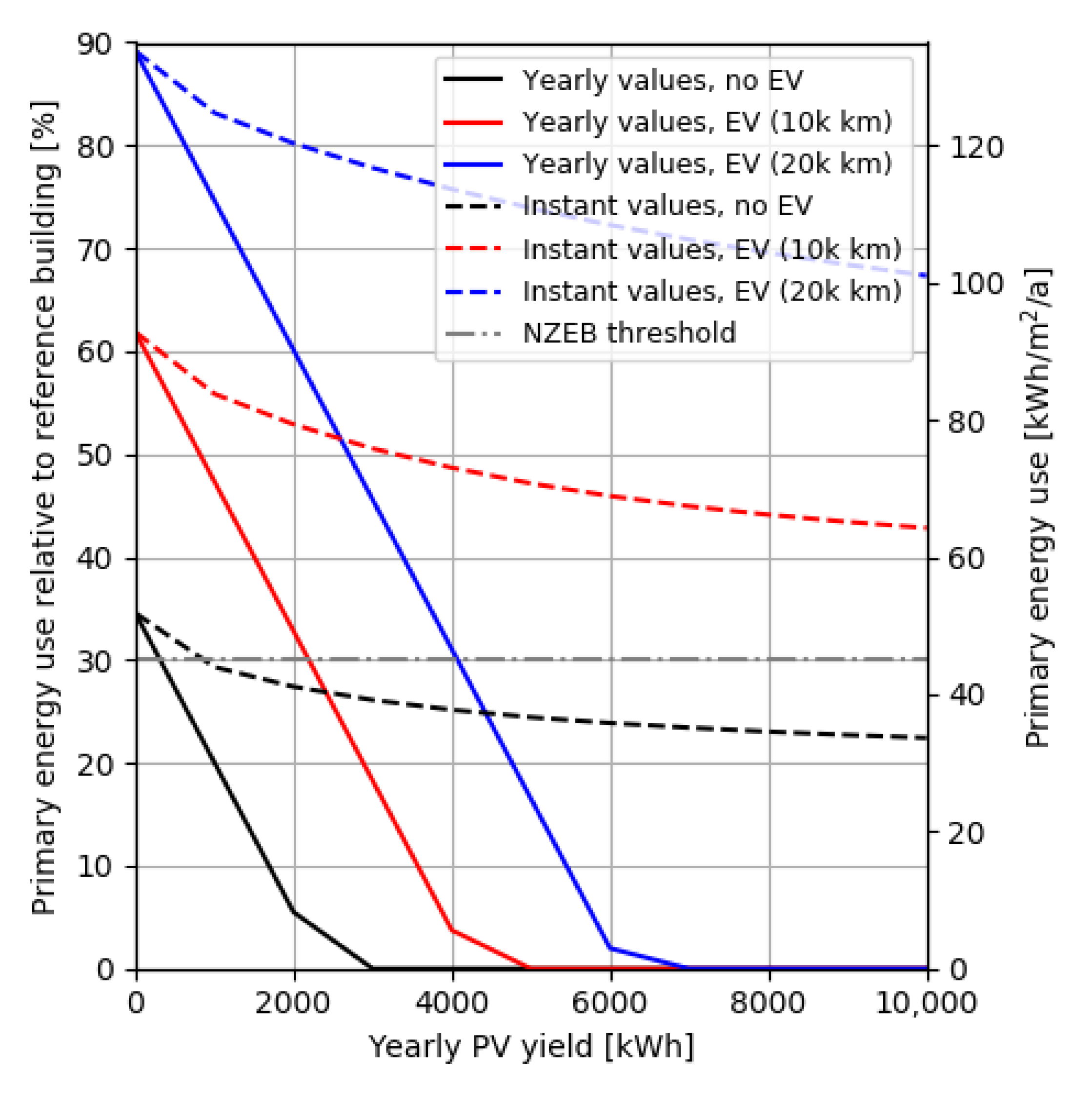
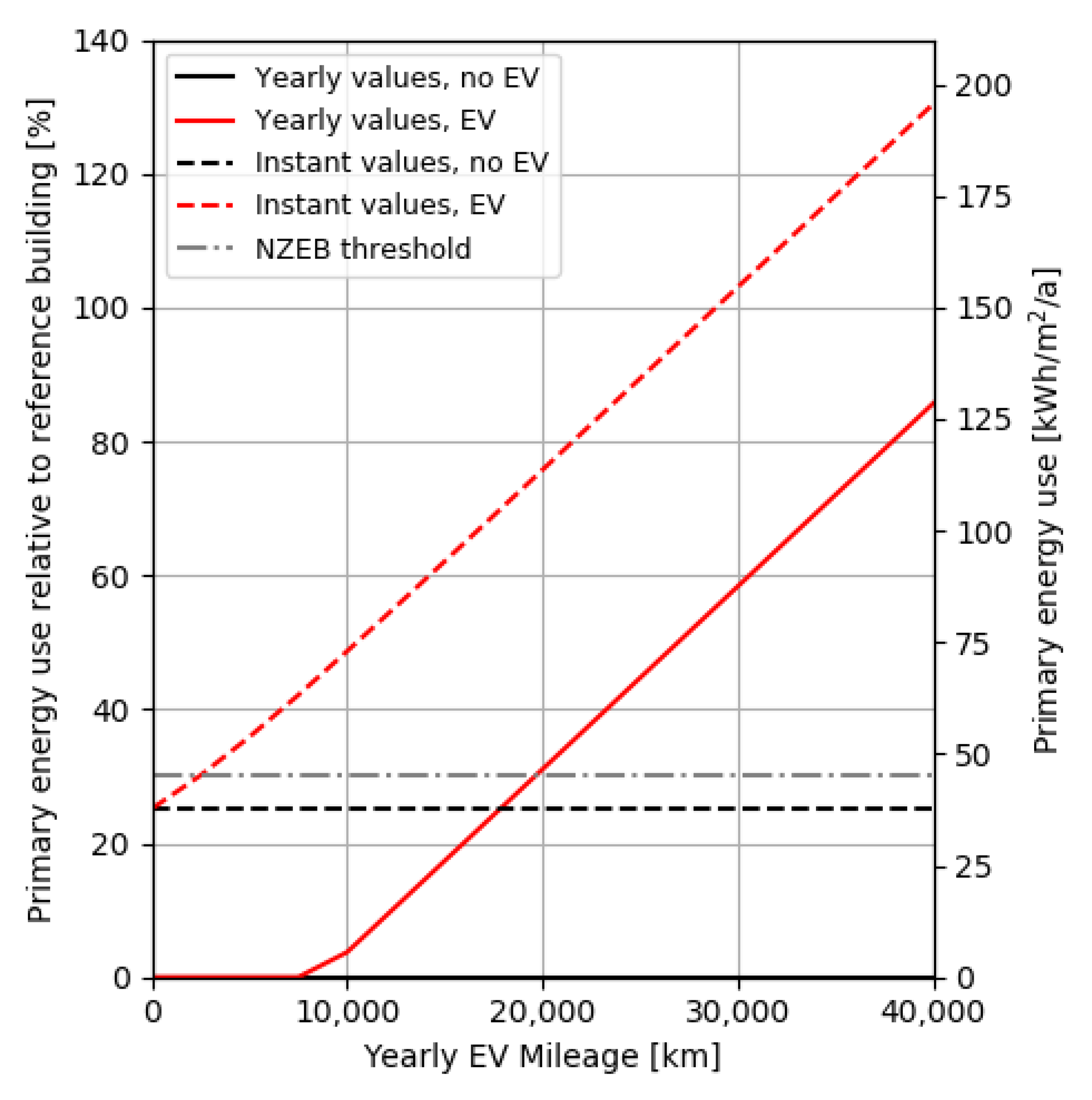

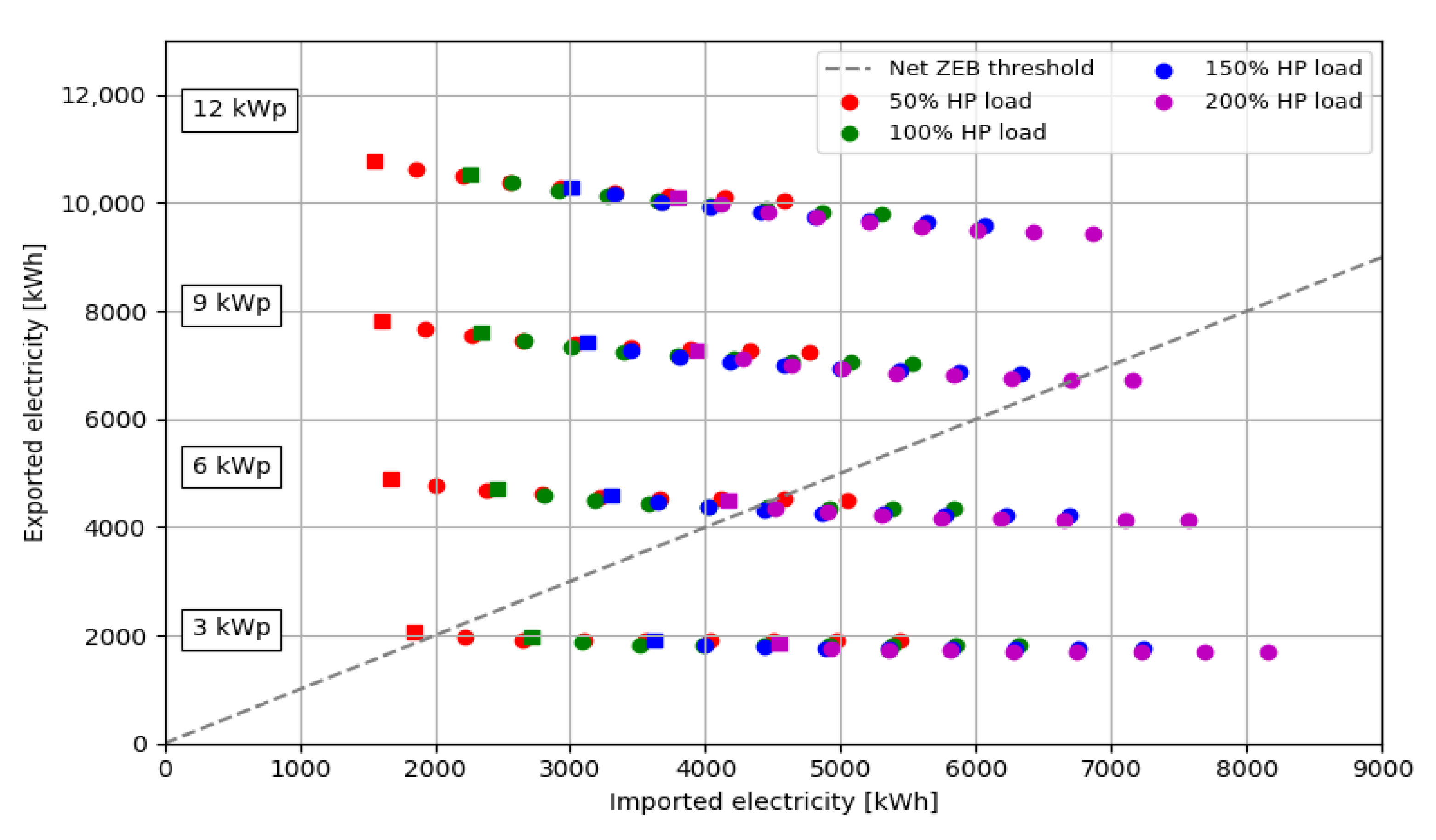
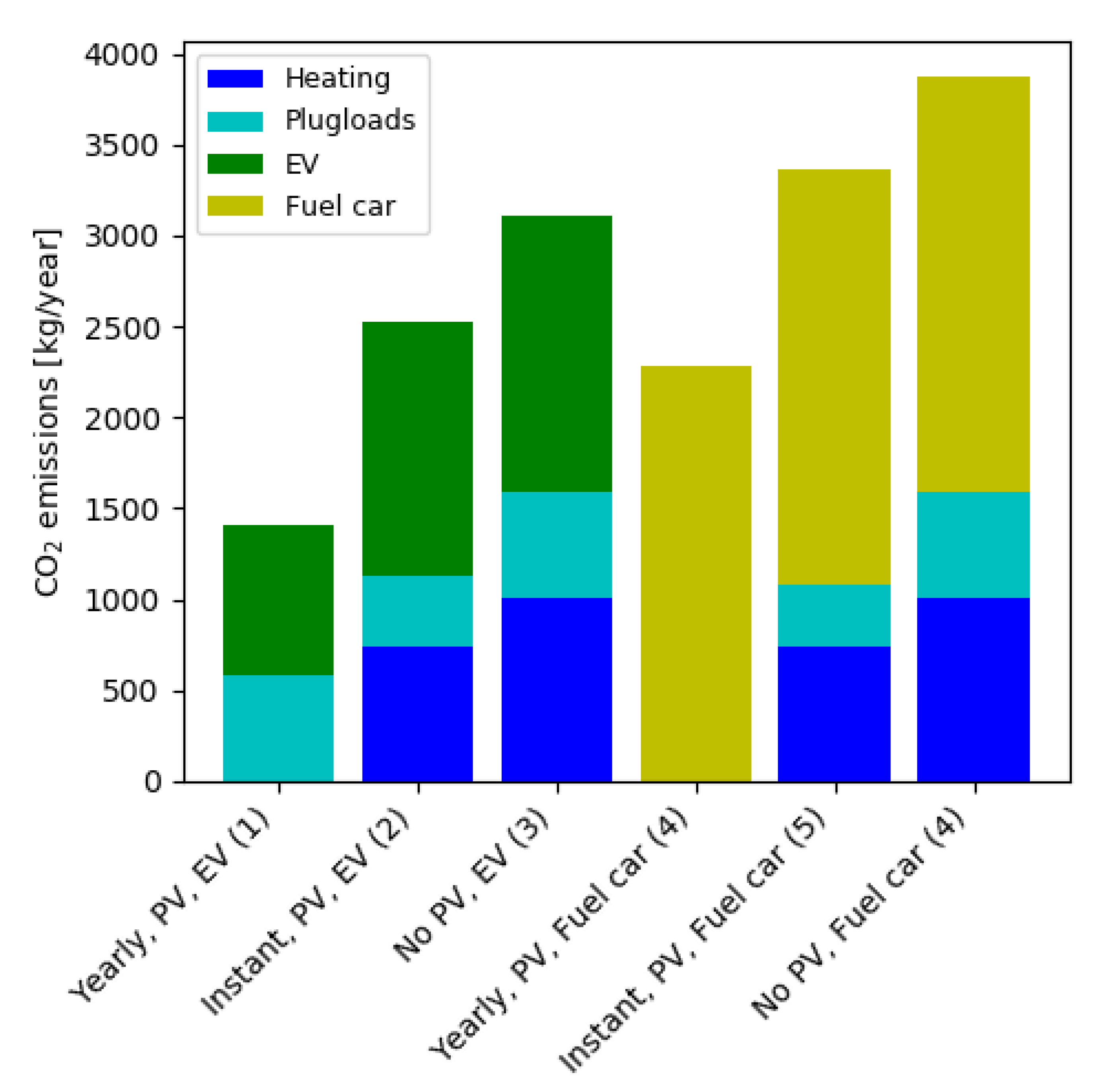
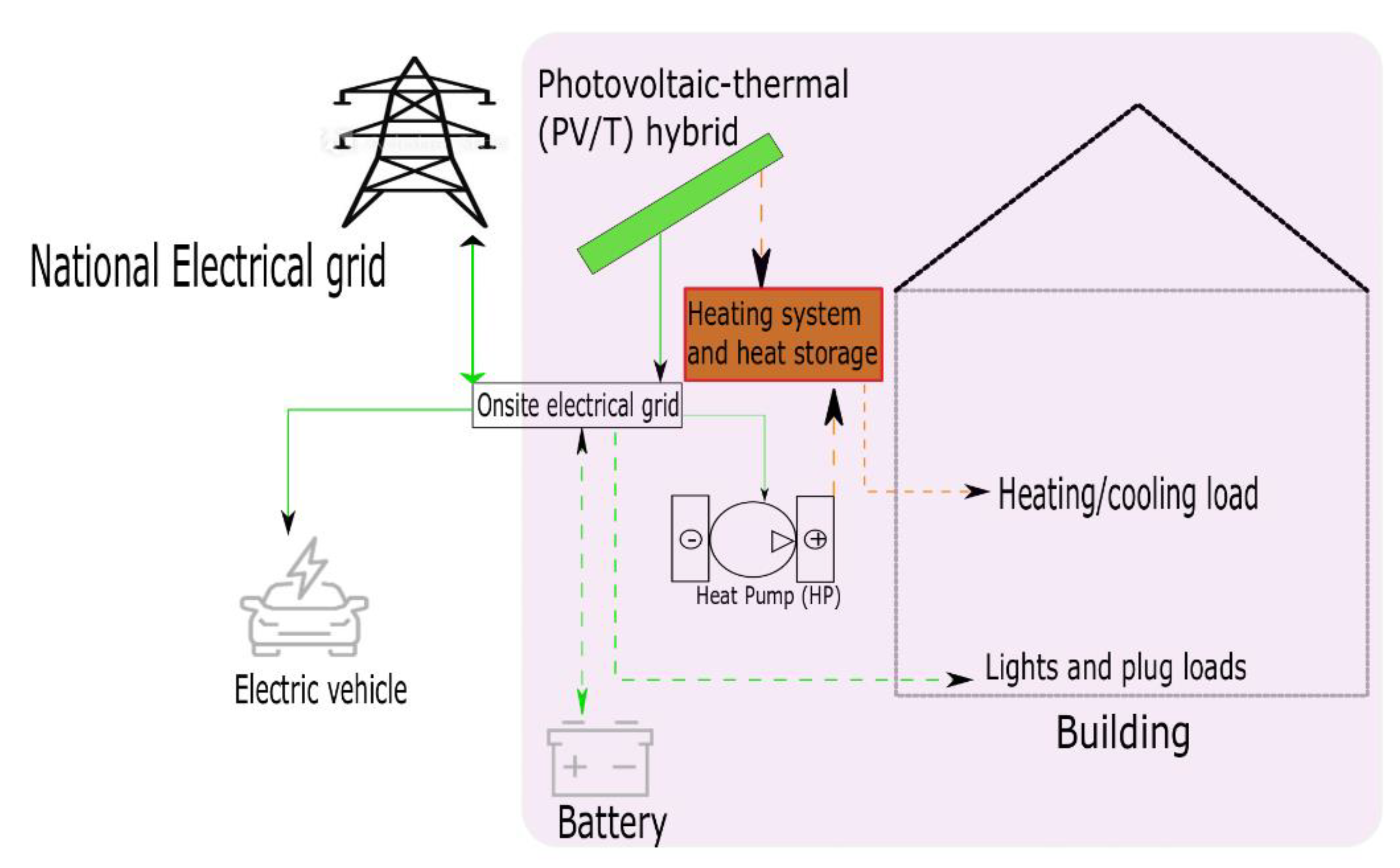
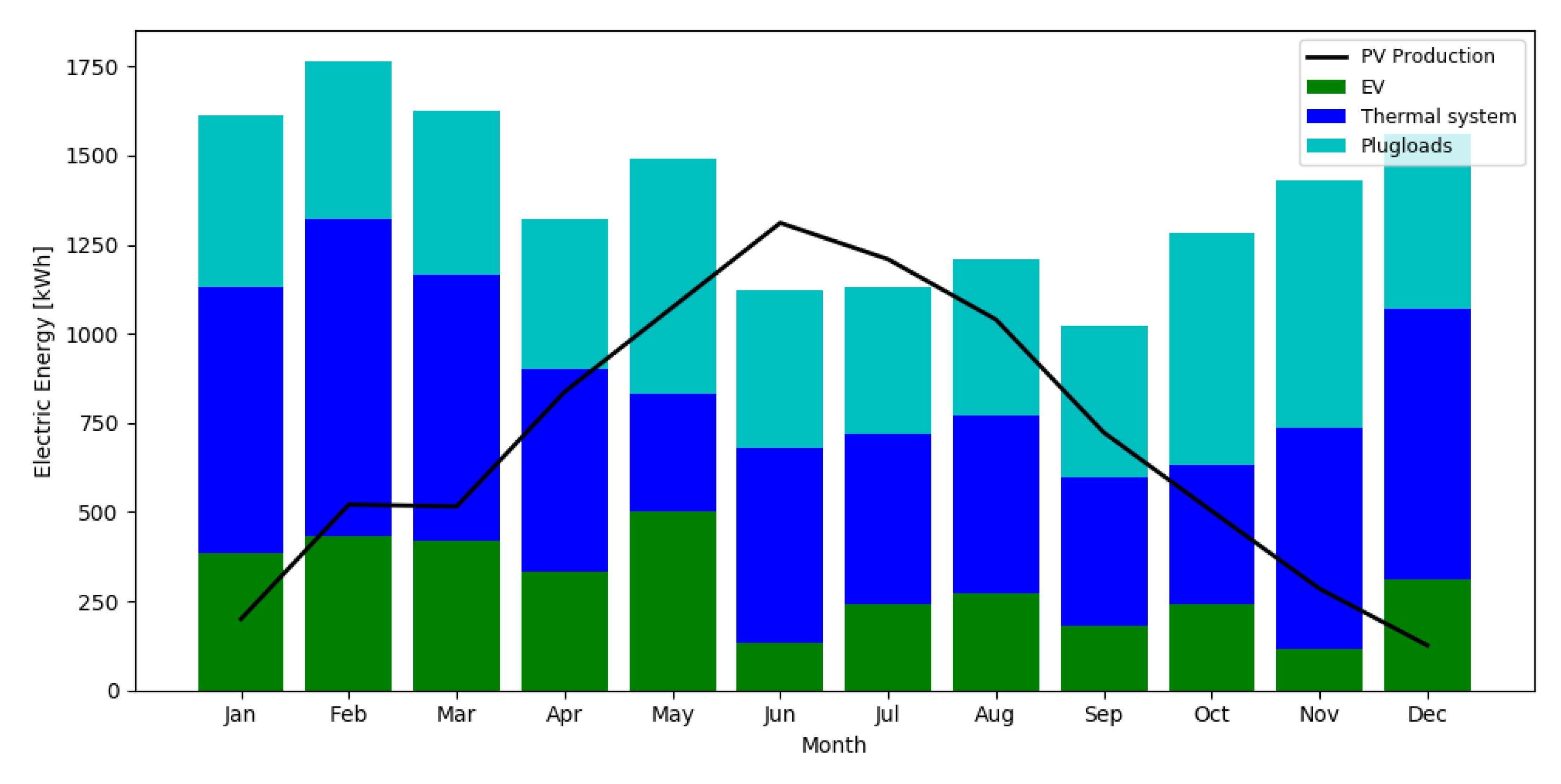
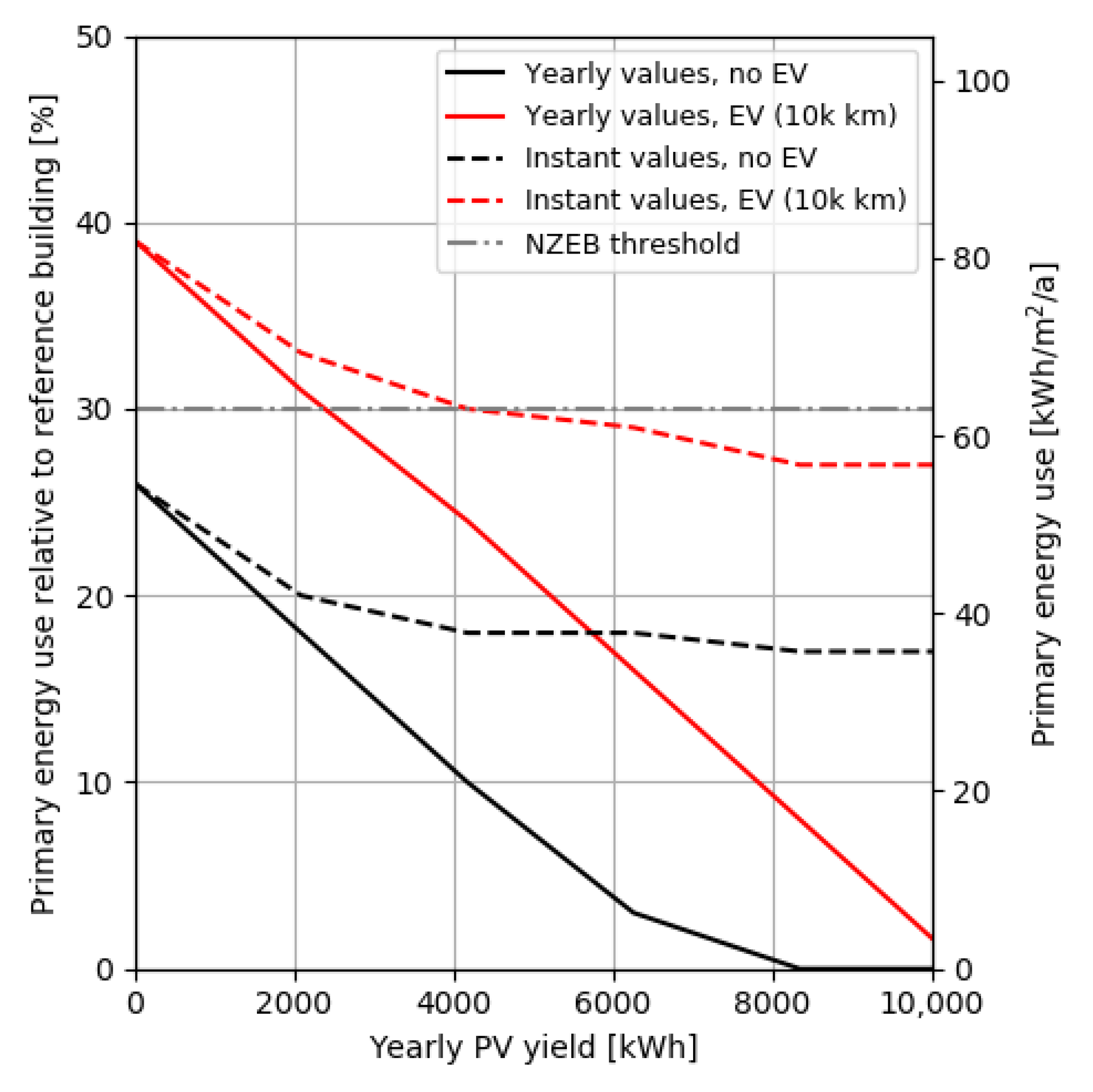
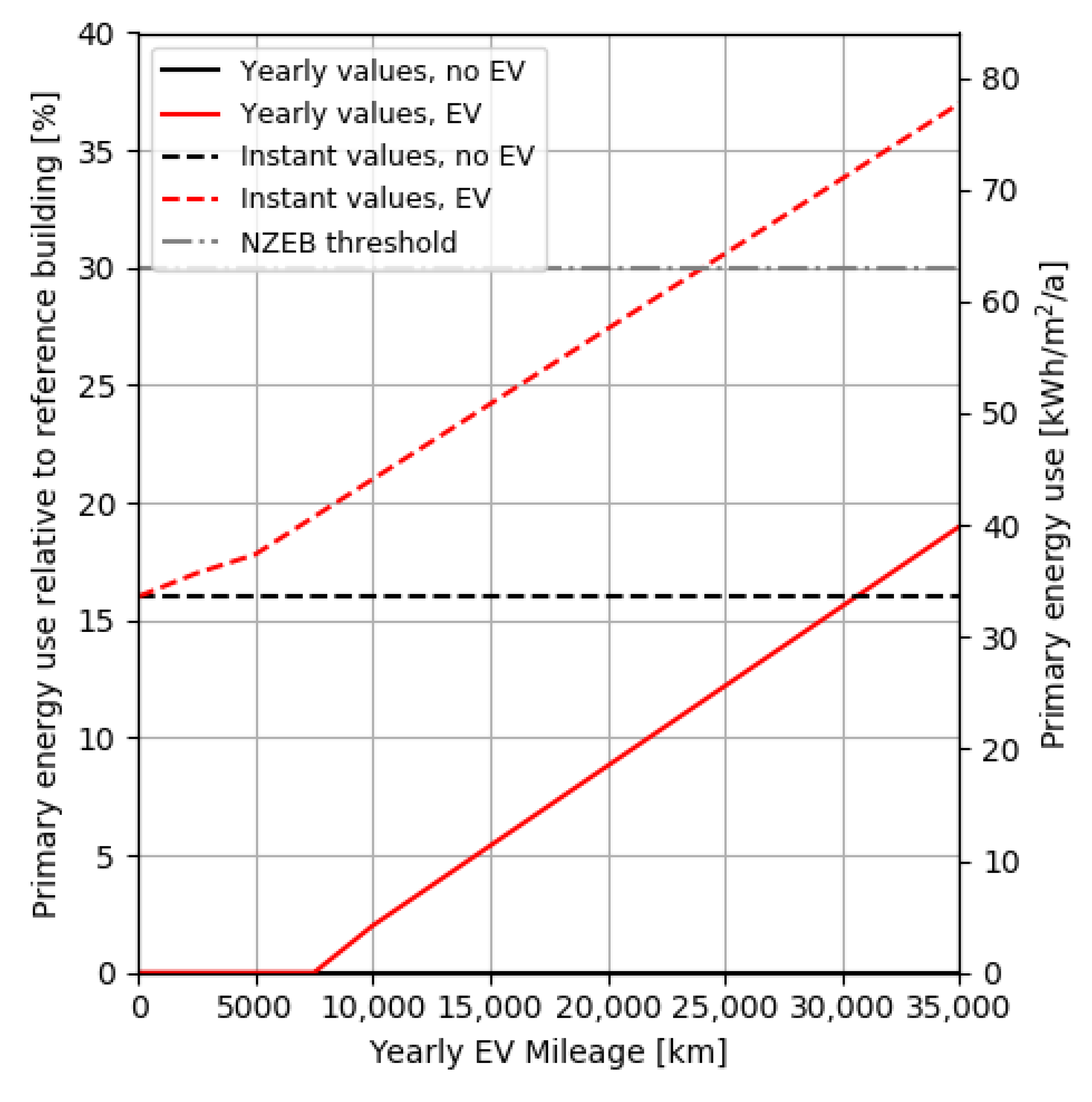
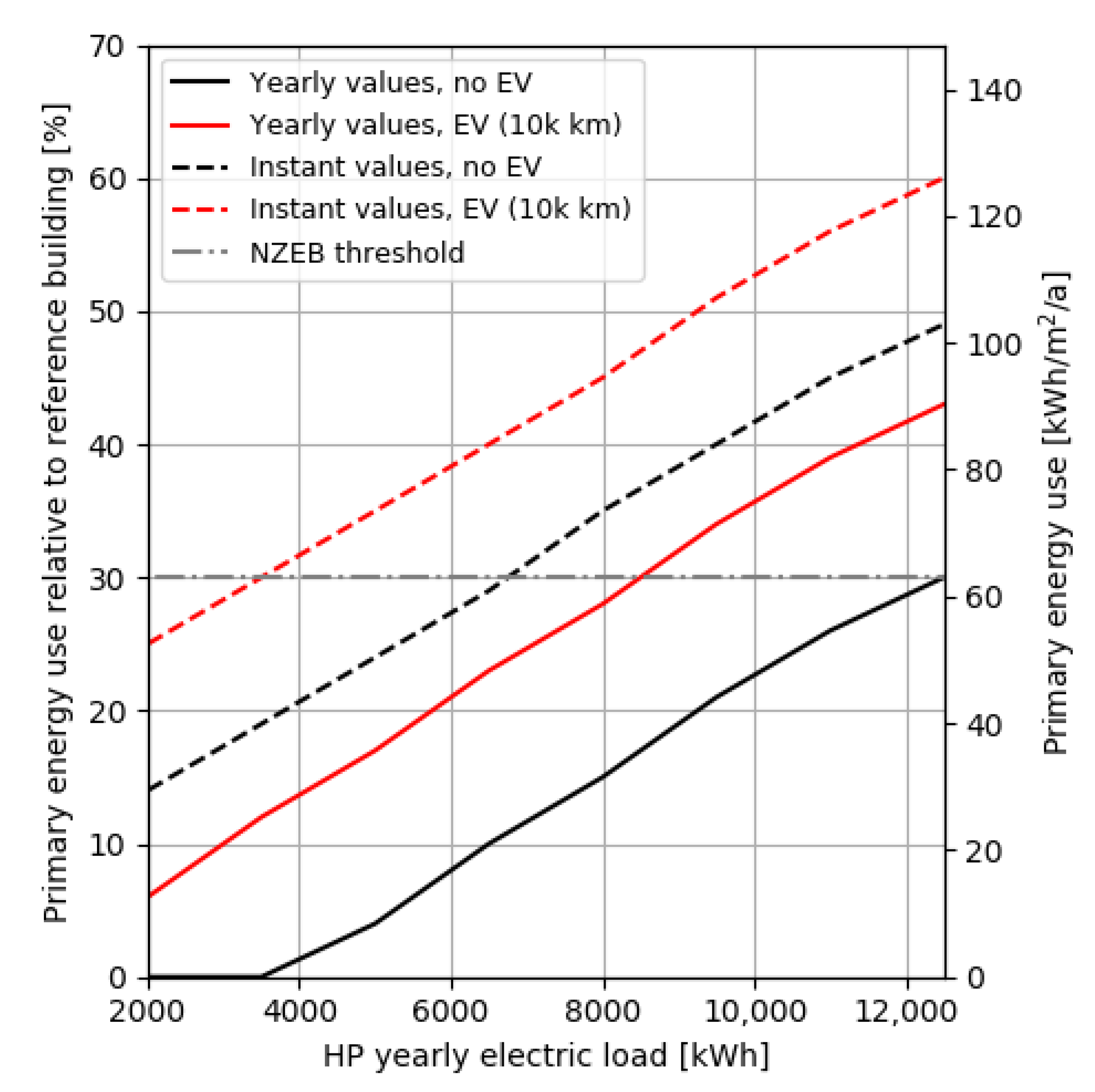
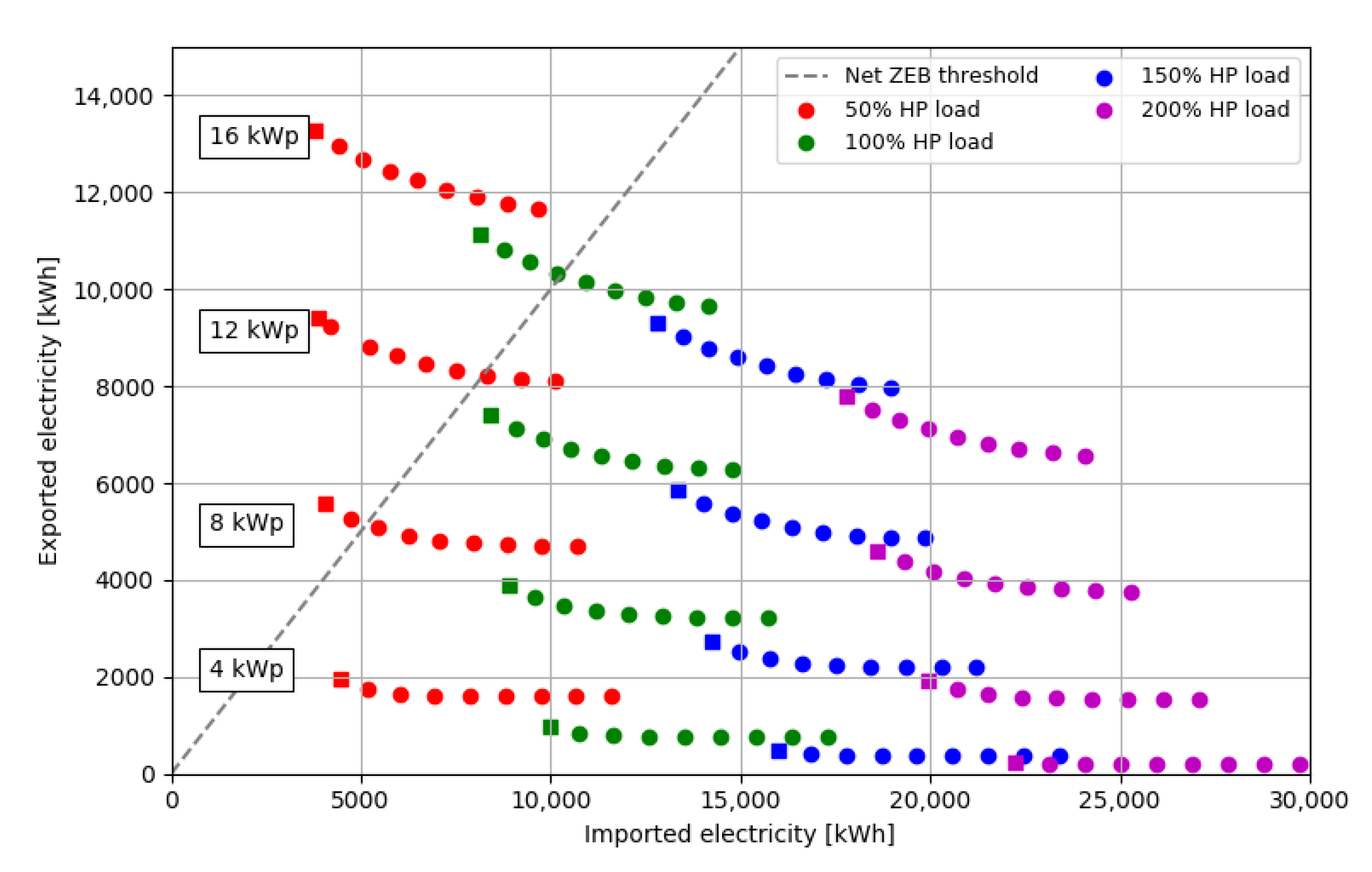
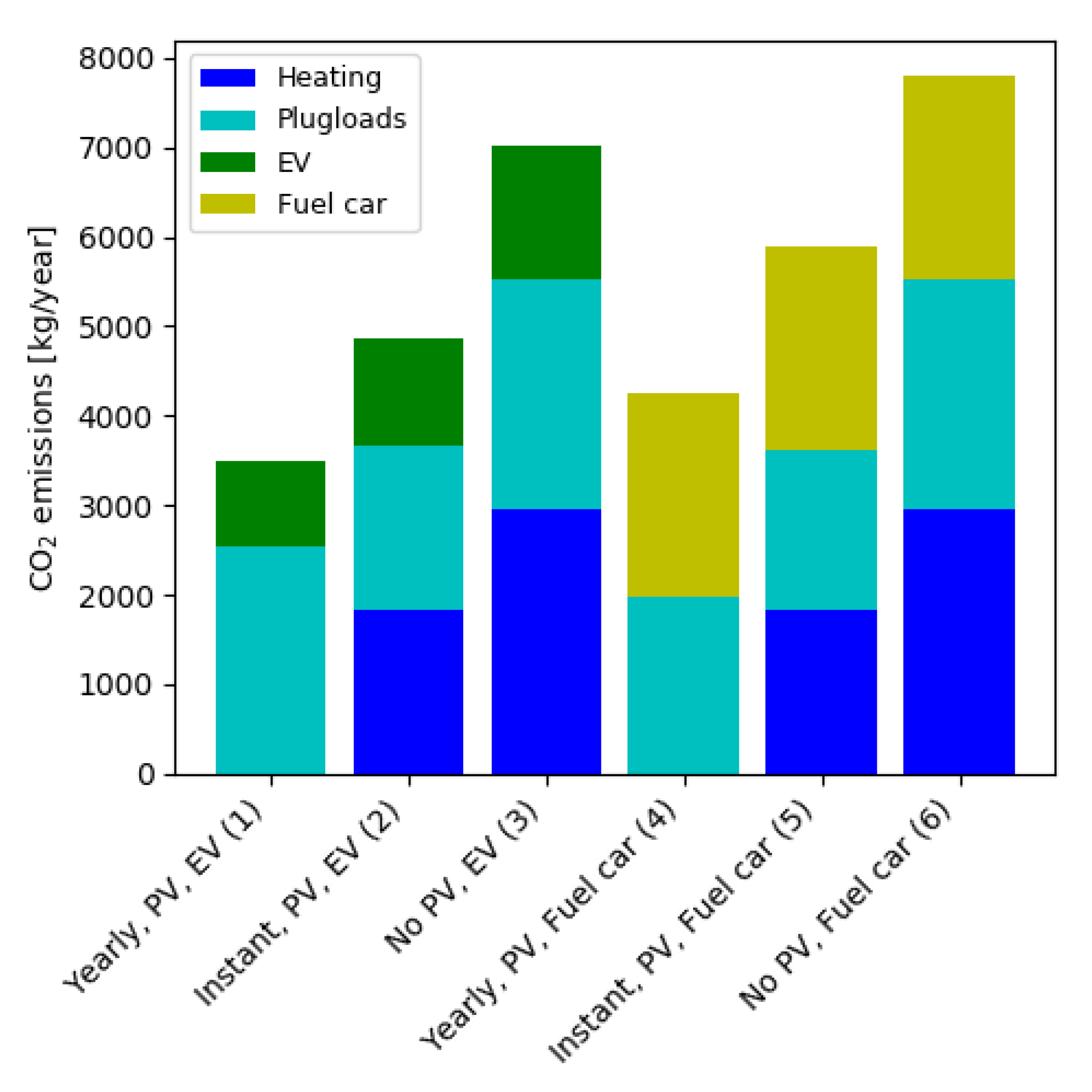
| Country | Residential Building Primary Energy Requirements (kWh/m2/a) | Electric Vehicle | Auxiliary | Lighting | Plug Loads |
|---|---|---|---|---|---|
| Austria | 160 | x | ✔ | ✔ | ✔ |
| Belgium (Flanders) | 30% of the reference building | x | ✔ | x | x |
| Bulgaria | 30–50 | x | ✔ | ✔ | ✔ |
| Croatia | 33–41 | x | ✔ | ✔ | x |
| Cyprus | 100 | x | x | ✔ | x |
| Czech Republic | 75–80% of the PE factor | x | ✔ | ✔ | x |
| Denmark | 20 | ? | ? | ✔ | ? |
| Estonia | 50–100 | ✔ (if included in the boundary) | ✔ | ✔ | ✔ |
| Finland | 170–110 | ? | ✔ | ✔ | ✔ |
| France | 40–65 | x | ✔ | ✔ | x |
| Germany | 40% of the PE | x | ✔ | ✔ | x |
| Greece | Not defined | ? | ? | ? | ? |
| Hungary | 50–72 | x | ✔ | ✔ | ? |
| Italy | Class A1 | x | ✔ | ✔ | x |
| Latvia | 95 | x | ✔ | ✔ | ✔ |
| Lithuania | Class A+ + | ✔ | ✔ | ✔ | ✔ |
| Luxemburg | Class AAA | x | ✔ | x | x |
| Malta | 40 | x | ✔ | ✔ | x |
| Netherlands | 0 | ✔ | ✔ | ✔ | ✔ |
| Poland | 60–75 | x | x | x | x |
| Portugal | ? | x | ? | ✔ | ? |
| Slovakia | 32–54 | x | ✔ | x | x |
| Spain | Class A | ? | ? | ? | ? |
| Sweden | 30–75 | ? | ✔ | x | ? |
| United Kingdom | 44 | x | ✔ | ✔ | x |
| Parameter | Case Study 1: Terraced Single-Family Dwelling | Case Study 2: Belgian Single Family House |
|---|---|---|
| Building purpose | Residential | Mixed residential/office |
| Building footprint [m2] | 37.9 | 184.6 |
| Building volume [m3] | 299 | 1409 |
| Location [Lat, Lon] | 52°11 N 5°18 E | 50°50 N 4°39 E |
| Logged subsystems | ||
| Electricity to/from grid [kWh] | Y | Y |
| PV production [kWh] | Y | Y |
| EV load [kWh] | No EV present | Y |
| Total electric load (incl. lighting, appliances, …) [kWh] | Y | Y |
| Electricity spot price [€/kWh] | N | Y |
| Energy to/from batteries [kWh] | No batteries present | Y |
| Battery state-of-charge [kWh] | No batteries present | Y |
| HP electric load [kWh] | Y | Y |
| Ventilation system electric load [kWh] | N | Y |
| Pump status [On/off] | N | Y |
| Data range | 15 September 2017–15 September 2018 | 1 May 2017–1 May 2018 |
| Data resolution | 5 min | 15 min |
| Parameters | Values |
|---|---|
| PV production | 8345 kWh/a |
| Electricity, from grid | 11,789 kWh/a |
| Electricity, to grid | 3558 kWh/a |
| Net, from grid | 8231 kWh/a |
| EV load | 3567 kWh/a |
| Base load, total | 13,008 kWh/a (Energy system = 6989 kWh/a + Plug loads = 6019 kWh/a) |
| PV coverage | 50.3% |
| PV self-consumption | 57.4% |
| Electricity, cost of buying | €3513.60/a |
| Electricity, income from selling | €1095.43 |
| Electricity, net cost | €2418.16 |
| Case Study 1: EV (kg CO2/Year) | Case Study 1: Fuel Car (kg CO2/Year) | Case Study 2: EV (kg CO2/Year) | Case Study 2: Fuel Case (kg CO2/Year) | |
|---|---|---|---|---|
| No PV | 3100 | 3800 | 7000 | 7900 |
| Yearly, with PV | 1400 | 2400 | 3500 | 4100 |
| Instant, with PV | 2500 | 3400 | 5000 | 6000 |
Publisher’s Note: MDPI stays neutral with regard to jurisdictional claims in published maps and institutional affiliations. |
© 2021 by the authors. Licensee MDPI, Basel, Switzerland. This article is an open access article distributed under the terms and conditions of the Creative Commons Attribution (CC BY) license (https://creativecommons.org/licenses/by/4.0/).
Share and Cite
Rehman, H.u.; Diriken, J.; Hasan, A.; Verbeke, S.; Reda, F. Energy and Emission Implications of Electric Vehicles Integration with Nearly and Net Zero Energy Buildings. Energies 2021, 14, 6990. https://doi.org/10.3390/en14216990
Rehman Hu, Diriken J, Hasan A, Verbeke S, Reda F. Energy and Emission Implications of Electric Vehicles Integration with Nearly and Net Zero Energy Buildings. Energies. 2021; 14(21):6990. https://doi.org/10.3390/en14216990
Chicago/Turabian StyleRehman, Hassam ur, Jan Diriken, Ala Hasan, Stijn Verbeke, and Francesco Reda. 2021. "Energy and Emission Implications of Electric Vehicles Integration with Nearly and Net Zero Energy Buildings" Energies 14, no. 21: 6990. https://doi.org/10.3390/en14216990
APA StyleRehman, H. u., Diriken, J., Hasan, A., Verbeke, S., & Reda, F. (2021). Energy and Emission Implications of Electric Vehicles Integration with Nearly and Net Zero Energy Buildings. Energies, 14(21), 6990. https://doi.org/10.3390/en14216990








